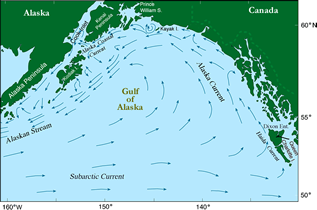Gulf of Alaska
The EcoFOCI Program conducts ecosystem research (physics to fish) in the eastern and western Gulf of Alaska. Goals of the research are to 1) identify and quantify the major oceanographic and ecosystem processes in the Gulf that regulate recruitment strength of key groundfish species (walleye pollock, Pacific cod, sablefish, Pacific ocean perch, and arrowtooth flounder), and 2) collect environmental data necessary to execute an Integrated Ecosystem Assessment (IEA). The Program conducts process research to link recruitment of commercially important species to environmental change, including climate change, and seeks to identify critical mechanisms linking climate to fish recruitment to improve 20-yr forecasts for commercially-important fishes.
The Gulf of Alaska Large Marine Ecosystem is rapidly changing due to climate warming. Sea temperatures have been anomalously warm, and process studies have provided critical data to illustrate that sustained periods of warming can change the trophic structure of the ecosystem, reducing energy to upper trophic level juvenile fishes, leading to increased winter mortality. Ongoing field work and modeling suggests that the manifestations of warming in the Gulf of Alaska (The Blob, El Nino, toxic algal blooms, small-copepod-dominated community, cetacean die-offs, and temperate and tropical fish species collected off Alaska’s coasts) will continue highlighting the need for continued research and monitoring of conditions and emergent events.
The EcoFOCI Program conducts regular, comprehensive fishery oceanographic surveys in the EGOA and WGOA using NOAA ships and chartered commercial fishing vessels. The established survey design is to conduct biennial ecosystem surveys in the WGOA and annual surveys in the EGOA, collecting data currents, water chemistry, eddies, winds, phytoplankton, zooplankton and fishes. Data from cross-trophic ecosystem surveys are utilized in stock assessment and fishery evaluation (SAFE) documents, in Integrated Ecosystem Assessments (IEA), and the Ecosystems Considerations Chapter to understand groundfish recruitment processes and salmon marine survival.



